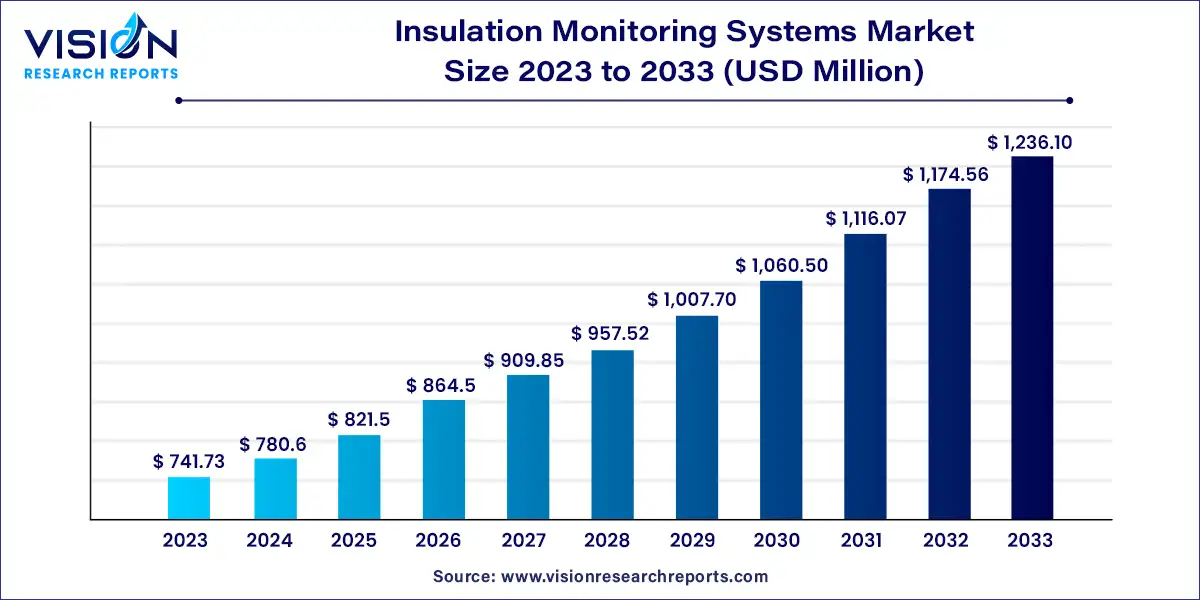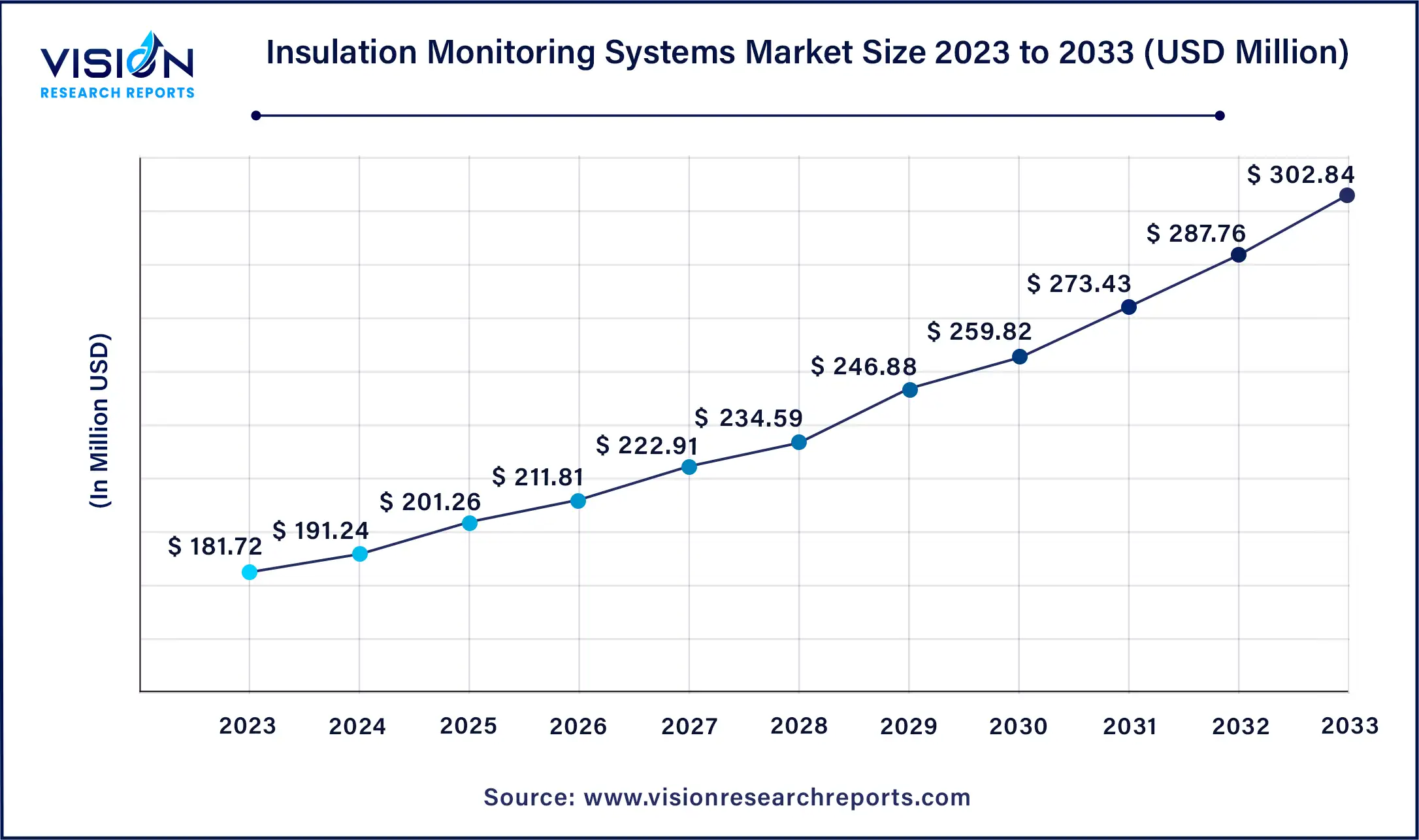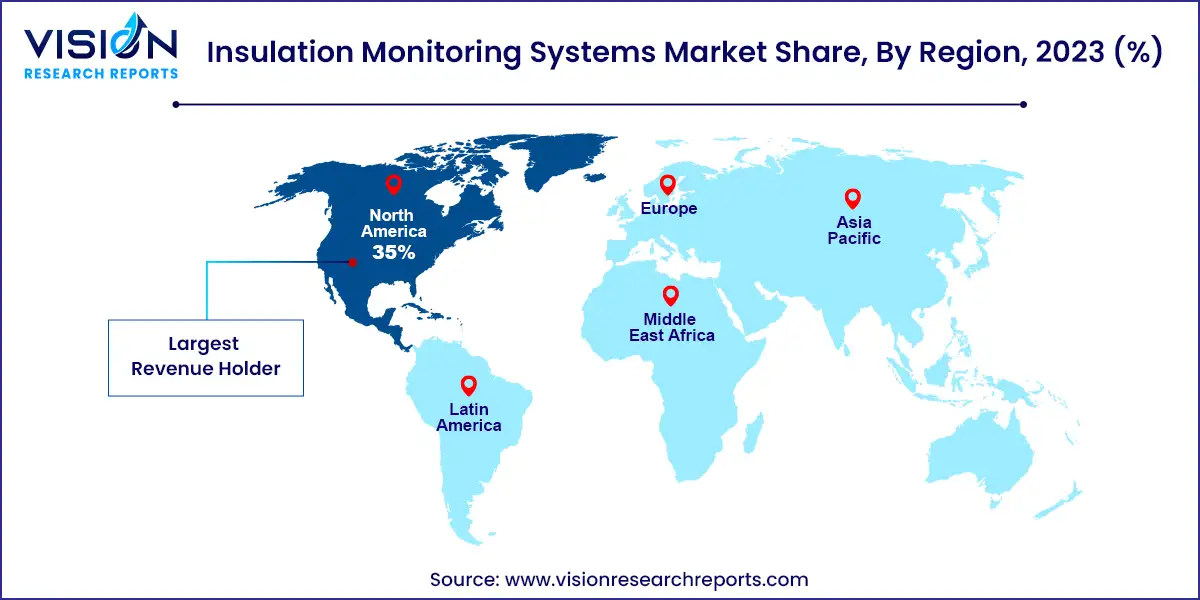The global insulation monitoring systems market size was estimated at USD 741.73 million in 2023 and it is expected to surpass around USD 1,236.1 million by 2033, poised to grow at a CAGR of 5.24% from 2024 to 2033.

Insulation monitoring systems (IMS) are critical components in electrical installations, ensuring safety and reliability by continuously monitoring the insulation integrity of electrical systems. These systems are essential in preventing electrical faults and protecting both equipment and personnel. The increasing complexity of electrical networks and the demand for higher safety standards are driving the growth of the Insulation Monitoring Systems market.
The insulation monitoring systems market is experiencing robust growth driven by the stringent safety regulations and standards enforced globally are compelling industries to adopt advanced monitoring solutions to ensure compliance and mitigate risks associated with electrical faults. These regulations necessitate the installation of reliable insulation monitoring systems to safeguard both personnel and equipment. Additionally, the rapid expansion of infrastructure projects, driven by urbanization and industrialization, increases the need for sophisticated electrical monitoring solutions to maintain system integrity. Technological advancements also play a crucial role, as innovations in digital and smart monitoring systems enhance accuracy and operational efficiency, appealing to a broader range of applications.
In 2023, North America dominated the insulation monitoring systems market, holding a 35% share of global revenue. This leadership is attributed to stringent safety regulations, a well-established industrial base, and early adoption of advanced technologies. The presence of major IMD players in North America also strengthens its market position. However, as awareness and regulations increase in other regions, North America's dominance may shift.
| Attribute | North America |
| Market Value | USD 259.60 Million |
| Growth Rate | 5.26% CAGR |
| Projected Value | USD 432.63 Million |
The U.S. insulation monitoring systems market size was estimated at around USD 181.72 million in 2023 and it is projected to hit around USD 302.84 million by 2033, growing at a CAGR of 5.26% from 2024 to 2033.

Key drivers include increased investments in grid modernization, growing adoption of renewable energy, and heightened focus on industrial automation. Additionally, stringent safety regulations enforced by agencies such as the Occupational Safety and Health Administration (OSHA) are further driving market expansion.
Europe Insulation Monitoring Systems Market Trends
The Europe insulation monitoring systems market is projected to grow steadily from 2024 to 2033. This growth is driven by rising investments in renewable energy projects, a focus on energy efficiency, and increased awareness of electrical safety standards. The presence of established market players and stringent European Union (EU) regulations also support a favorable market environment.

Asia Pacific Insulation Monitoring Systems Market Trends
The Asia Pacific insulation monitoring systems market is forecasted to grow significantly, with a CAGR of 6.33% from 2024 to 2033. This rapid growth is fueled by industrialization, increased infrastructure investments, and a rising demand for reliable power supply across various industries. Additionally, growing concerns about worker safety and the adoption of automation in manufacturing contribute to this growth, with China, India, and Japan leading the market expansion in the region.
In 2023, the single-phase insulation monitoring device (IMD) segment led the market, capturing over 42% of the global revenue. Single-phase IMDs are preferred for their simplicity, cost-effectiveness, and ease of installation, making them suitable for low-voltage applications such as residential buildings, branch circuits, and individual motors. Their dominance is expected to persist in areas with a high prevalence of these applications. However, as electrical systems become more complex, there is an anticipated shift toward three-phase devices.
The three-phase insulation monitoring device segment is projected to grow at a faster compound annual growth rate (CAGR) from 2024 to 2033. Three-phase IMDs offer comprehensive monitoring capabilities for complex industrial and commercial environments with three-phase power systems. They provide detailed insights into insulation faults across all phases, helping to prevent costly downtime and equipment damage. With increased automation and electrification in sectors like manufacturing and renewable energy, the demand for three-phase IMDs is expected to see the most rapid growth in the coming years.
In 2023, the power utilities sector was the leading market segment for insulation monitoring devices. Power utilities prioritize safety and reliability, making them major users of IMDs to ensure the integrity of transmission and distribution lines, prevent outages, and safeguard critical infrastructure. As utilities modernize grids and incorporate renewable energy sources, advanced IMDs will be crucial for maintaining system stability and efficiency.
The manufacturing and production sector is anticipated to experience the fastest growth rate from 2024 to 2033. The sector's heightened focus on worker safety and production efficiency drives demand for IMDs. Early detection of insulation faults reduces the risk of electrical accidents and equipment failures, improving operational uptime. IMDs also aid in optimizing energy consumption by identifying inefficiencies due to deteriorating insulation. This emphasis on safety, efficiency, and cost savings is expected to drive substantial growth in the IMD market within the manufacturing and production industries.
By Type
By Industry Vertical
By Region
Chapter 1. Introduction
1.1. Research Objective
1.2. Scope of the Study
1.3. Definition
Chapter 2. Research Methodology
2.1. Research Approach
2.2. Data Sources
2.3. Assumptions & Limitations
Chapter 3. Executive Summary
3.1. Market Snapshot
Chapter 4. Market Variables and Scope
4.1. Introduction
4.2. Market Classification and Scope
4.3. Industry Value Chain Analysis
4.3.1. Raw Material Procurement Analysis
4.3.2. Sales and Distribution Channel Analysis
4.3.3. Downstream Buyer Analysis
Chapter 5. COVID 19 Impact on Insulation Monitoring System Market
5.1. COVID-19 Landscape: Insulation Monitoring System Industry Impact
5.2. COVID 19 - Impact Assessment for the Industry
5.3. COVID 19 Impact: Global Major Government Policy
5.4. Market Trends and Opportunities in the COVID-19 Landscape
Chapter 6. Market Dynamics Analysis and Trends
6.1. Market Dynamics
6.1.1. Market Drivers
6.1.2. Market Restraints
6.1.3. Market Opportunities
6.2. Porter’s Five Forces Analysis
6.2.1. Bargaining power of suppliers
6.2.2. Bargaining power of buyers
6.2.3. Threat of substitute
6.2.4. Threat of new entrants
6.2.5. Degree of competition
Chapter 7. Competitive Landscape
7.1.1. Company Market Share/Positioning Analysis
7.1.2. Key Strategies Adopted by Players
7.1.3. Vendor Landscape
7.1.3.1. List of Suppliers
7.1.3.2. List of Buyers
Chapter 8. Global Insulation Monitoring System Market, By Type
8.1. Insulation Monitoring System Market, by Type, 2024-2033
8.1.1. 1 Phase Insulation Monitoring Device
8.1.1.1. Market Revenue and Forecast (2021-2033)
8.1.2. 3 Phase Insulation Monitoring Device
8.1.2.1. Market Revenue and Forecast (2021-2033)
8.1.3. DC Insulation Monitoring Device
8.1.3.1. Market Revenue and Forecast (2021-2033)
Chapter 9. Global Insulation Monitoring System Market, By Industry Vertical
9.1. Insulation Monitoring System Market, by Industry Vertical, 2024-2033
9.1.1. Power Utilities
9.1.1.1. Market Revenue and Forecast (2021-2033)
9.1.2. Manufacturing and Production
9.1.2.1. Market Revenue and Forecast (2021-2033)
9.1.3. Transportation
9.1.3.1. Market Revenue and Forecast (2021-2033)
9.1.4. Healthcare
9.1.4.1. Market Revenue and Forecast (2021-2033)
9.1.5. Mining
9.1.5.1. Market Revenue and Forecast (2021-2033)
9.1.6. Others
9.1.6.1. Market Revenue and Forecast (2021-2033)
Chapter 10. Global Insulation Monitoring System Market, Regional Estimates and Trend Forecast
10.1. North America
10.1.1. Market Revenue and Forecast, by Type (2021-2033)
10.1.2. Market Revenue and Forecast, by Industry Vertical (2021-2033)
10.1.3. U.S.
10.1.3.1. Market Revenue and Forecast, by Type (2021-2033)
10.1.3.2. Market Revenue and Forecast, by Industry Vertical (2021-2033)
10.1.4. Rest of North America
10.1.4.1. Market Revenue and Forecast, by Type (2021-2033)
10.1.4.2. Market Revenue and Forecast, by Industry Vertical (2021-2033)
10.2. Europe
10.2.1. Market Revenue and Forecast, by Type (2021-2033)
10.2.2. Market Revenue and Forecast, by Industry Vertical (2021-2033)
10.2.3. UK
10.2.3.1. Market Revenue and Forecast, by Type (2021-2033)
10.2.3.2. Market Revenue and Forecast, by Industry Vertical (2021-2033)
10.2.4. Germany
10.2.4.1. Market Revenue and Forecast, by Type (2021-2033)
10.2.4.2. Market Revenue and Forecast, by Industry Vertical (2021-2033)
10.2.5. France
10.2.5.1. Market Revenue and Forecast, by Type (2021-2033)
10.2.5.2. Market Revenue and Forecast, by Industry Vertical (2021-2033)
10.2.6. Rest of Europe
10.2.6.1. Market Revenue and Forecast, by Type (2021-2033)
10.2.6.2. Market Revenue and Forecast, by Industry Vertical (2021-2033)
10.3. APAC
10.3.1. Market Revenue and Forecast, by Type (2021-2033)
10.3.2. Market Revenue and Forecast, by Industry Vertical (2021-2033)
10.3.3. India
10.3.3.1. Market Revenue and Forecast, by Type (2021-2033)
10.3.3.2. Market Revenue and Forecast, by Industry Vertical (2021-2033)
10.3.4. China
10.3.4.1. Market Revenue and Forecast, by Type (2021-2033)
10.3.4.2. Market Revenue and Forecast, by Industry Vertical (2021-2033)
10.3.5. Japan
10.3.5.1. Market Revenue and Forecast, by Type (2021-2033)
10.3.5.2. Market Revenue and Forecast, by Industry Vertical (2021-2033)
10.3.6. Rest of APAC
10.3.6.1. Market Revenue and Forecast, by Type (2021-2033)
10.3.6.2. Market Revenue and Forecast, by Industry Vertical (2021-2033)
10.4. MEA
10.4.1. Market Revenue and Forecast, by Type (2021-2033)
10.4.2. Market Revenue and Forecast, by Industry Vertical (2021-2033)
10.4.3. GCC
10.4.3.1. Market Revenue and Forecast, by Type (2021-2033)
10.4.3.2. Market Revenue and Forecast, by Industry Vertical (2021-2033)
10.4.4. North Africa
10.4.4.1. Market Revenue and Forecast, by Type (2021-2033)
10.4.4.2. Market Revenue and Forecast, by Industry Vertical (2021-2033)
10.4.5. South Africa
10.4.5.1. Market Revenue and Forecast, by Type (2021-2033)
10.4.5.2. Market Revenue and Forecast, by Industry Vertical (2021-2033)
10.4.6. Rest of MEA
10.4.6.1. Market Revenue and Forecast, by Type (2021-2033)
10.4.6.2. Market Revenue and Forecast, by Industry Vertical (2021-2033)
10.5. Latin America
10.5.1. Market Revenue and Forecast, by Type (2021-2033)
10.5.2. Market Revenue and Forecast, by Industry Vertical (2021-2033)
10.5.3. Brazil
10.5.3.1. Market Revenue and Forecast, by Type (2021-2033)
10.5.3.2. Market Revenue and Forecast, by Industry Vertical (2021-2033)
10.5.4. Rest of LATAM
10.5.4.1. Market Revenue and Forecast, by Type (2021-2033)
10.5.4.2. Market Revenue and Forecast, by Industry Vertical (2021-2033)
Chapter 11. Company Profiles
11.1. AB Trasmissioni Srl
11.1.1. Company Overview
11.1.2. Product Offerings
11.1.3. Financial Performance
11.1.4. Recent Initiatives
11.2. ABB, Acrel Co., Ltd.
11.2.1. Company Overview
11.2.2. Product Offerings
11.2.3. Financial Performance
11.2.4. Recent Initiatives
11.3. ALLIED POWER SOLUTIONS
11.3.1. Company Overview
11.3.2. Product Offerings
11.3.3. Financial Performance
11.3.4. Recent Initiatives
11.4. Bender GmbH & Co. KG
11.4.1. Company Overview
11.4.2. Product Offerings
11.4.3. Financial Performance
11.4.4. LTE Scientific
11.5. Blue Jay Technology Co. Ltd.
11.5.1. Company Overview
11.5.2. Product Offerings
11.5.3. Financial Performance
11.5.4. Recent Initiatives
11.6. HAKEL spol. s r.o.
11.6.1. Company Overview
11.6.2. Product Offerings
11.6.3. Financial Performance
11.6.4. Recent Initiatives
11.7. HELLA GmbH & Co. KGaA
11.7.1. Company Overview
11.7.2. Product Offerings
11.7.3. Financial Performance
11.7.4. Recent Initiatives
11.8. Legrand
11.8.1. Company Overview
11.8.2. Product Offerings
11.8.3. Financial Performance
11.8.4. Recent Initiatives
11.9. Omron Corporation
11.9.1. Company Overview
11.9.2. Product Offerings
11.9.3. Financial Performance
11.9.4. Recent Initiatives
11.10. Schneider Electric
11.10.1. Company Overview
11.10.2. Product Offerings
11.10.3. Financial Performance
11.10.4. Recent Initiatives
Chapter 12. Research Methodology
12.1. Primary Research
12.2. Secondary Research
12.3. Assumptions
Chapter 13. Appendix
13.1. About Us
13.2. Glossary of Terms
 Cross-segment Market Size and Analysis for
Mentioned Segments
Cross-segment Market Size and Analysis for
Mentioned Segments
 Additional Company Profiles (Upto 5 With No Cost)
Additional Company Profiles (Upto 5 With No Cost)
 Additional Countries (Apart From Mentioned Countries)
Additional Countries (Apart From Mentioned Countries)
 Country/Region-specific Report
Country/Region-specific Report
 Go To Market Strategy
Go To Market Strategy
 Region Specific Market Dynamics
Region Specific Market Dynamics Region Level Market Share
Region Level Market Share Import Export Analysis
Import Export Analysis Production Analysis
Production Analysis Others
Others